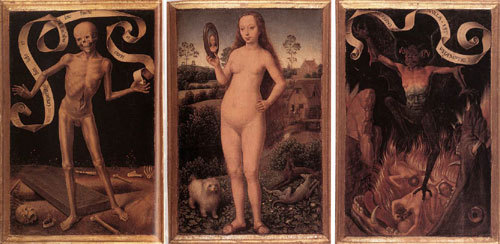Normally I’m not really into art. Actually, I’m not that into music either, ironically. I rarely take the time to just appreciate the arts. I don’t like concerts or shows unless I’m performing. I don’t even listen to music as often as others. I like to make music sometimes, but my appreciation is far less than others I’ve met.
That said, I’ve been thinking about art’s place in church. We recently put up some really tacky, generic art in the social area. Yeah, it’s a bunch of crosses and other decor, but it’s just so bleh. It’s like stuff from Linens ‘n Things. I think it’s a waste of an opportunity. Why is music so prevalent in churches, but good art is overlooked? Once in church we did a huge mural that everyone could draw on. That was cool. Even though I don’t know how to express myself well through art, some people thrive on it.
Perhaps church people are afraid to offend with art, and want to create a “comfortable” atmosphere. If I had my way there would be walls full of murals, kids’ art, famous paintings, and modern art – such that you could just gaze on it for hours. Some would be shocking, some would be reverent, some full of meaning, some with hidden meaning. It might be tacky to an interior designer, but I bet artists would get a lot out of it.
Here’s a sculpture my buddy Brandon did when we were roommates in college:

The bible had blood spattered on it, and the verse in Romans about dying to yourself and living for Christ was circled. Now, I’m no artist, but I have always remembered this piece of art and its meaning. It’s beautiful! This is applicable to the Christian life – killing the bad parts of yourself – and this is a great way to remember it. This is the kind of art I would love to see in church. Some people might complain about kids seeing it, but they see stuff worse than that on TV every day.
One of my quotes here (the ones at the bottom) is “Memento Mori” – which was a popular theme in ancient Rome and all throughout history – meaning “Remember that you will die.” The idea was similiar to “Carpe Diem” which most people have heard of. This idea made its way into a lot of Christian art. “To the Christian, the prospect of death serves to emphasize of the emptiness and fleetingness of earthly pleasures, luxuries, and achievements, and thus also as an invitation to focus one’s thoughts on the prospect of the afterlife.” You can read more about this here.
On that page was a link to a work by Hans Memling in 1485, shown below:
This facinated me with its symbolism and captures the idea quite well. You can read more about the painting here. This would be another of the sort of picture I would love to see in church! It’s meaningful even 500 years after it was done.
Anyway, that’s my rant about art. Something like that would require putting aside our comfortable “Linens ‘n Things” style, but one of the values of our chuch is reaching people with the good news, even if it is outside our normal style. What a unique way to do this!

Leave a Reply